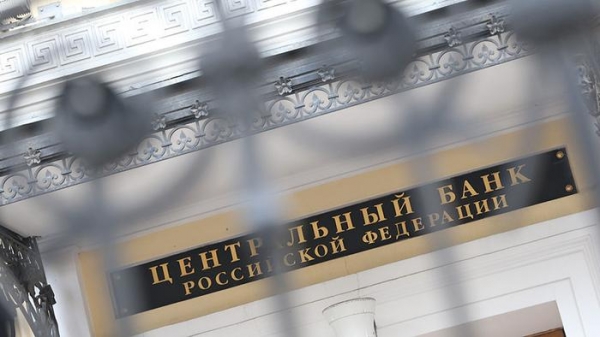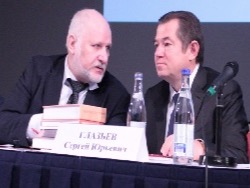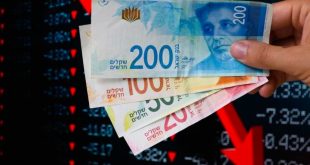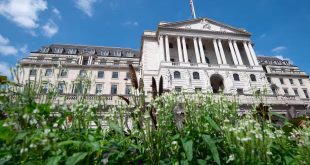
The Ministry of economic development believes that the Central Bank will be able to lower the level of inflation in Russia to 4% by the end of 2017. The policy of inflation targeting pursued by the controller, the de facto holding back the recovery of the domestic economy. But the head of the Central Bank Elvira Nabiullina ready to stand your ground no matter what.
The government approved a new forecast of socio-economic development prepared by the Ministry of economic development. “We believe that the corridor of $40-60 per barrel is the new reality, the new normal for the next five years”, — said Deputy Minister Alexei Vedev. The baseline scenario is based on the price of Urals oil in $40 in 2016-2019. Shock scenario would be a drop in prices to $25 per barrel.
According to the MAYOR, the Russian economy can move to growth in the third quarter of this year, but for the year overall GDP in 2016 will decrease by 0.2%. Next year the economy will grow only by 0.8%.
One of the factors constraining the recovery, supports the policy of the Central Bank, which holds, in his words, “a moderately tight monetary policy” to reduce inflation to 4% by the end of 2017.
The Ministry believes this goal is unrealistic. “We proceed from the assumption that inflation will continue to decline. And this year will be reduced to 6.5% by the end of the year”, — said Alexei Ulyukayev (at the end of March it amounted to 7.2%, at the end of December last year — a 12.9 per cent). Starting in 2017, according to him, it “remains stable below 5%, and by the end of 2019 will be reduced to 4%”.
If the forecast of economic development for the current year are correct, then inflation will fall to historically low levels, which previously was recorded only in 2011-2013 (at 6.1–6.6%).
It is worth noting that the highest rates of GDP growth (6,4–8,5%) in Russia for the last 15 years occurred in 2003-2007, when the growth rate of consumer prices did not fall below 9%, and in 2003 it reached 12%. At the lowest level of inflation in 2011-2013, the growth rate slowed from 4.3% to 1.3%. It is obvious that for the Russian economy low inflation is not critical to growth. Need long and cheap loans and a stable national currency, low administrative barriers for business. The first two points is a direct area of responsibility of the Central Bank.
But the regulator is not going to help economic growth. More precisely, he believes that we must first rein in inflation to 4%, and then will automatically begin to rise, because falling interest rates. “The fact that we are now entering the level until 2014, we should not allow ourselves to relax. We must not lose vigilance. Because there is a risk that we will be stuck at 6-7%,” — said Elvira Nabiullina, speaking at the Collegium of the Ministry of Finance. She called this level “totally unacceptable”.
In her view, the price increase of 6-7% per year may not ensure economic growth through investment. Therefore, “our commitment to return to sustained growth we see in the decline, especially, and the consolidation of inflation at persistently low levels,” Nabiullina said, reiterating the commitment to achieve the inflation level of 4% by the end of 2017.
Because of the low inflation will not be low long-term interest rates in the economy and predictability of business conditions that are critical to economic growth,” she explained.
It is interesting that these 4% are not the result of some calculations and in fact unfounded. The Central Bank explained that to set a goal of 2%, as do developed Western countries, it would be too ambitious, and inflation of 6% is not enough low. Therefore, it was chosen benchmark of 4%.
From the intended path Nabiullina has promised not to turn off, indicating that monetary policy needs to be consistent. But the fact of the matter is that the actions of the Central Bank of hard to call it consistent. At the end of last year, the Central Bank repeatedly declared that it would begin to reduce the rate (it is at 11%) as the reduction of inflation.
“With the slowdown of inflation in accordance with the forecast, the Bank of Russia will resume the reduction of the key rate on one of the next meetings of the Board of Directors,” noted, for example, in a press release following the meeting of the Board of Directors of the Central Bank on 30 October 2015. That is, it would be logical to expect that at least in March the rate will fall to single digit percentages. But this did not happen.
In January, the regulator changed its mind and now focuses not on the actual rate of inflation, and inflation risks and inflation expectations. Moreover, the Central Bank on the results of the January meeting said that “in case of strengthening of inflationary risks the Bank of Russia does not exclude the tightening of monetary policy.” In a press release following the meeting of the Board of Directors of 18 March 2016, the Bank of Russia admits that the actual inflation in March 2016 was significantly lower than predicted. But the perceived risks and expectations are again not allowed him to reduce the key rate.
The key rate serves as an indicator and the actual lower bound for the commercial banks in determining interest rates on loans to businesses and households. The higher it is, the more expensive credit for households and businesses. The current 11% of the Central Bank transformirovalsya eventually in 25-30% of the population and 15-20% for business.
At a recent Stock forum, Deputy Prime Minister Arkady Dvorkovich noted that at a rate of 20% per annum, no investment project can not be profitable, if they are not selling weapons, drugs and other similar types of activities.”
“If we talk about lawful business, at such rate, not lend,” said Dvorkovich, adding that the banks themselves such a policy provoke defaults on loans.
The same was said and the representatives of the agricultural sector, Prime Minister Dmitry Medvedev at the forum “the Modern Russian village.” “Yes, is it possible 16-20%? Yes this is robbery in broad daylight! They have 3-5%. If we are going to borrow at 20%, why engage? To work in banks only?” — applause of the audience, the General Director of agricultural enterprise “Ageddomains” Vasily Mariskin.
The result of this policy, the Central Bank has been a sharp drop in demand for borrowed funds and a decline in the share of Bank loans in the total volume of investment financing. If in 2008, according to Rosstat, it was 11.8%, in 2015-7.8%.
The high rate could be compensated target cheap liquidity from the Central Bank for crediting of investment projects. But Elvira Nabiullina opposed the proposal of the Ministry of economic development to expand the program for project financing of 100 billion rubles, which is being funded by the Central Bank and the limit which is now chosen by about 70%.
“Project Finance we have doubts. In my opinion, the analysis of the projects shows that there are many projects that can be financed on a commercial basis by commercial banks”, — said the head of the Central Bank at a press conference on March 18.
In the context of high interest rates increases the demand of enterprises for the support of the budget. The most successful examples of state support in recent years concerned the subsidization of lending to the automotive and housing markets, which shows the potential demand for these instruments, especially in conditions of high interest rates. So, almost every third apartment, bought a mortgage in 2015, has been acquired by the state program of subsidizing interest rates.
The government has to compensate for the failures of the policies of the Bank of Russia, however, the Bank of Russia often expresses dissatisfaction with certain policies of the government, threatening to tighten monetary policy, if the Cabinet will be more to help the economy.
Another aspect of high interest rates (and the support of the Ministry of Finance in its efforts to reduce budget expenditures, including for the indexation of salaries to state employees and pensions) is that the crushed incomes and consumer demand. By the end of 2015, real wages declined by 9.3% that led to a significant reduction in consumer demand — retail trade turnover fell by 10%.
In dollar terms, wages generally decreased by 2.5 times — from $900 in 2013 to $400 by the end of 2015, while maintaining the consumption patterns of a significant proportion of imports is a significant reduction in the ability of high-quality consumption, especially for the middle class. However, these trends are interpreted by the Bank of Russia exclusively as a positive in terms of their impact on the achievement of the inflation target.
The economic development Ministry is waiting for the minimum growth of incomes and demand in 2017. “The forecast assumes that in 2017, an increase of 0.8%, real wage by 1.2%. Almost appropriate values will be in retail sales, an increase of 1.1%,” — said Alexei Ulyukayev.
The fact that tight monetary policy restrains consumer demand and investment activity, understood in the Bank of Russia, but to retreat from their positions, the regulator does not want.
“Of course, we understand that the availability of credit, low, interest rates are quite high for our businesses. And we intend to reduce the key rate, but not at the expense of inflation. We should not allow the situation when we bet will reduce, and inflation will rise,” said Elvira Nabiullina in interview to TV channel “Russia”.
She believes the illusion of the view that rate cuts can spur economic growth. Growth requires structural reforms, she said (here it would be nice to add and import substitution and modernization of fixed assets to increase productivity and improve product quality). However, how to carry out reforms without money and without consumers, Nabiullina explained.
It is important to note that such head-on following the policy of “inflation targeting” have not accepted. Even an apologist for this course — international monetary Fund — have long recognized their mistakes.
In the report “Rethinking macroeconomic policy” (2010) has identified key shortcomings of the macroeconomic policy of the past two decades and called for a review of many of the established postulates, which in the conditions of crisis of 2008-2009 has shown its inefficiency. Among these basic tenets — orientation policy of the Central banks to maintain stable inflation as the primary or even the only goal and the belief that inflation should not only be stable, but extremely low.
The crisis has shown that the issue may vary and the presence of stable inflation. In the last decade it became clear that macroeconomic models do not fully explain the behavior of inflation and its relationship (especially when its a low level) with economic activity. At the same time, as the experience of the 2000-ies, the stability of indicators of output and inflation does not mean that in certain sectors of the economy is not rising prices and the accumulation of imbalances that may cause significant negative effects.
It is obvious that in the framework of the policy of the Bank of Russia (as well as in macroeconomic policies in the country as a whole) need to be reoriented with demand constraints on the increased supply of goods and services in the country. This will allow not only to achieve lower inflation in the short term, but also to ensure its stability in the long term. The primary decision in this direction should be the reduction of the key rate of the Bank of Russia.








